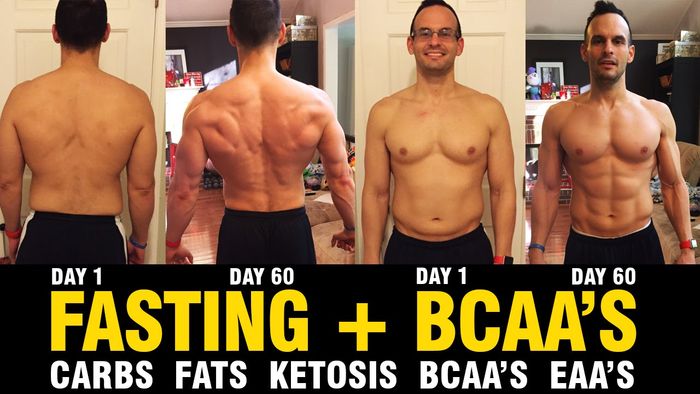Amino Acids: EAA’s & BCAA’s
Last Updated on June 17, 2023
Essential Amino Acids
As the name implies, EAA’s are essential because they can’t simply be made by your body like all the other amino acids can. Instead, you have to get EAA’s from your diet or other exogenous sources.
Essential amino acids are also known as “indispensable amino acids”, and are basically an amino acid that cannot be synthesized de novo (from scratch) by an organism, and thus must be supplied in that organism’s diet. The nine amino acids humans cannot synthesize are phenylalanine, valine, threonine, tryptophan, methionine, leucine, isoleucine, lysine, and histidine.
Six other amino acids are considered conditionally essential in the human diet, meaning their synthesis can be limited under special conditions, such as prematurity in the infant or individuals in severe catabolic distress (e.g. you decided to do Crossfit Murph with a weighted backpack, twice). These six are arginine, cysteine, glycine, glutamine, proline, and tyrosine. Five other amino acids are dispensable in humans, meaning they can actually be synthesized in your body. These five are alanine, aspartic acid, asparagine, glutamic acid and serine.
Phenylalanine is traditionally marketed for its analgesic (pain-killing) and antidepressant effect, and is a precursor to the synthesis of norepinephrine and dopamine, two “feel-good” brain chemicals. This could be good because elevated brain levels of norepinephrine and dopamine may actually lower your “RPE” or Rating of Perceived Exertion During Exercise, which means you could be happier when you’re suffering halfway through a killer workout session, an Ironman bike ride, an obstacle race, or any voluminous or intense event. It is also needed for the formation of our metabolism-regulating thyroid hormones.
Valine, along with Isoleucine and Leucine, is a real player because it is BOTH an Essential Amino Acid and a Branched Chain Amino Acid (BCAA – more on those pesky amino acids later). It can help to prevent muscle proteins from breaking down during exercise. This means that if you take Valine during exercise, you could recover faster because you’d have less muscle damage. More details on that below, when we delve into BCAA’s. It is also involved in stimulating the central nervous system, regulating blood sugar levels, and with normal growth and development.
Threonine research is a bit scant. Its main role is to help maintain the balance of protein within the body, making it essential for normal growth and development. Threonine is required to produce the amino acids serine and glycine. Glycine has been getting a lot of attention lately as research has uncovered its ability to promote muscle growth and inhibit muscle loss, its role in collagen production which repairs and protects the joints, ligaments, and tendons, its role in repairing the digestive tracts, its role in the formation of glutathione, its regulation of the nervous system, and in aiding restful sleep.
Tryptophan is an interesting one. It is a precursor for serotonin, a brain neurotransmitter that can suppress pain, and if you’re taking some before bed at night, it even induces a bit of sleepiness. The main reason to take tryptophan would be to increase tolerance to pain during hard workouts, games or races. But studies to this point go back and forth on whether or not that actually improves performance. Tryptophan is also needed to manufacture vitamin B3, which assists with blood sugar regulation, prevents free radical damage, and prevents the build-up of cholesterol.
Isoleucine, another BCAA that has some of the same advantages of Valine. Again…more on BCAA’s coming in a sec.
Methionine helps your body process and eliminate fat. It contains sulfur, a substance that is required for the production of the body’s most abundant natural antioxidant, glutathione. Your body also needs plenty of methionine to produce two other sulfur-containing amino acids, cysteine and taurine, which help the body eliminate toxins, build strong, healthy tissues, and promote cardiovascular health. Methionine is a “lipotropic”, which means it helps your liver process fats, prevents accumulation of fat in the liver and ensures normal liver function, which is essential for the elimination of toxins from your body. Methionine also supports liver function by regulating glutathione supplies – glutathione is needed to help neutralize toxins in the liver.
Histidine, as the name implies, is a precursor to histamine, and actually has some antioxidant properties and plays a key role in carnosine synthesis. What does that mean, exactly? Here’s a clarification: histamine could help you fight off the cell-damaging free radicals you produce during exercise, and carnosine helps you get rid of muscle burn more quickly and helps turn lactic acid back into useable muscle fuel. Interestingly, though histidine is often listed as “essential,” it is not technically essential because when you take an EAA supplement, the levels of histidine in your blood will rise within one hour. But Tim and biology professors worldwide might be pissed if we abbreviate Tim Hall to Tim All, so we’ll roll with the mnemonic for now.
Next is arginine, and if you’re reading this and you’re an old man who has relied on a little blue pill called Viagra to have a happier time in the sack, you can thank arginine. Arginine helps with nitric oxide synthesis, and nitric oxide is a vasodilator that increases blood flow and could help with exercise capacity (in the case of the blue pill, for one specific body part). Most of the studies on arginine show that it also helps folks with cardiovascular disease improve exercise capacity.
Leucine is yet another BCAA that supports muscle building. It also helps to maintain the nitrogen balance and energy supply within the body… Yes, as I keep promising, we will get to BCAA’s very soon.
Lysine is something my Mom used to take to help cold sores that she got from eating citrusy foods. That’s basically because it helps heal mouth tissue. But more importantly for exercising individuals, lysine may actually assist with growth-hormone release, which could vastly improve muscle repair and recovery, although if you take lysine in it’s isolated form, the amount you’d have to take to increase growth hormone release would cause gastrointestinal distress, or as I like to call it, sad poopies. But combined with all the other essential amino acids, there may be a growth hormone response in smaller doses, and there is some clinical evidence that essential amino acid supplementation could stimulate growth hormone releasing factors. It is also used in the development of antibodies and has important antiviral properties, both of which help support a healthy immune system.
There is a significant muscle-preserving effect of essential amino acids supplements when ingested, especially during training in a fasted state or ketotic state, and this includes decreased indicators of muscle damage and inflammation. This basically means that if you popped some essential amino acids, even if you didn’t eat anything, you wouldn’t “cannibalize” as much lean muscle during a fasted workout session, a long intermittent fast, a bout of ketosis, or a marathon, Ironman triathlon or any other long, voluminous or relatively intense event.
Consuming an essential amino acid mixture after resistance training increases muscle protein synthesis and net muscle protein balance, indicating that ingesting EAA’s post workout may stimulate faster muscle repair, recovery and growth. Yet another study showed the potential for EAA’s to cause muscle growth and regeneration through them being a potent rapamycin complex 1 (mTORC1) activator (activating cell growth), causing muscle satellite cell proliferation. As you age, your muscle produces less or has a delayed ability to proliferate satellite cells in response to exercise, which is bad news, since satellite cells are essential for skeletal muscle regeneration. But older men who consumed EAA’s after resistance exercise had greater satellite cell proliferative capacity than those who didn’t supplement. This is especially important information if you’re at all interested in anti-aging, since muscle mass and resistance training keep you young.
Dr. Minkoff says: “For most people who do not have gigantic bodies, 10 grams of amino acids consumed 3 times a day would be maximum the body could use. If more are taken, they will just be metabolized into sugar or stored as fat. Taking more than 10 grams of amino acids at a time can also do the same thing.”
So the answer would be that for supplementing with essential amino acids no more than 30 grams per day (and my personal protocol involves one handful of ten essential amino acid tablets or two spoonfuls of essential amino acid powder taken 1-2 times per day, always on an empty stomach, and usually before, during or after a workout – especially any workout that I perform while in ketosis or in a fasted state on an empty stomach).
Branched Chain Amino Acids
BCAA’s are quite interesting because they are metabolized in your muscle, rather than in your liver. This means that BCAA’s, without any requirement for much digestion or “processing” at all, can be relied on as an actual energy source during exercise, and could therefore prevent premature muscle breakdown. There was actually one compelling study done by a guy named Ohtani that showed exercising individuals who got BCAA’s had better exercise efficiency and exercise capacity compared to a group that didn’t get BCAA’s.
Daily leucine supplementation to untrained men aged 18-29 participating in a resistance training protocol increased their power output from 31% to 40% without affecting lean mass or fat mass changes. BCAA’s, particularly leucine, appear to stimulate skeletal muscle protein synthesis.
Other studies have found that BCAA’s could increase a variety of factors that are really useful for anyone who cares about their physical performance…like red blood cell count, hemoglobin, hematocrit and serum albumin. They can also lower fasting blood glucose and decrease creatine phosphokinase, which means less inflammation, better red blood cell formation, and better formation of storage carbohydrate.
But that ain’t all.
BCAA supplementation after exercise has been shown to cause faster recovery of muscle strength, and even more interestingly, the ability to slow down muscle breakdown even during intense training and “overreaching” (getting very close to overtraining). This same study found an increase in the oxygen-carrying capacity of blood.
When you supplement with BCAA’s, they can decrease the blood indicators of muscle tissue damage after long periods of exercise, thus indicating reduced muscle damage. They also help maintain higher blood levels of amino acids, which, if you recall from the EAA explanation above, can make you feel happier even when you’re suffering hard during exercise. So as you may have guessed, low blood levels of BCAA’s are correlated with increased fatigue and reduced physical performance.
A 2011 study found that BCAA supplementation caused a 17.2% increase in time to fatigue in glycogen-depleted subjects and enhanced lipid oxidation, or using fat for fuel.
Heck, they even use BCAA’s in medicine. BCAA’s could help people recover from liver disease, could assist with improvements in patients with lateral sclerosis, and could help recovery in patients who have gone through trauma, extreme physical stress (can you say “triathlon”, “Crossfit WOD”, “obstacle race” or “airline travel”?), kidney failure, and burns. They even help prevent muscle loss in bedridden patients, so if you’re injured an unable to exercise, supplementing with amino acids is a good idea.
BCAA’s seem to enhance mental performance as well. During a 32 hour offshore sailing event, BCAA’s reduced fatigue and mental errors. BCAA’s have also been reported to preserve cognition during extended periods of exercise, a useful benefit for sports requiring decision making and reaction time.
But here is what I think could be the most interesting things about BCAA’s, especially for fat loss:
1. In his book, “SuperHealth: The Last Diet You’ll Ever Need”, my friend KC Craichy swears by them for significantly decreasing your appetite when taken 30-60 minutes prior to exercise.
2. When taken prior to a fasted exercise session, BCAA’s could increase fat oxidation (and yes, I’ll actually cite a study for this one, it was “Branched-chain amino acids supplementation enhances exercise capacity and lipid oxidation during endurance exercise after muscle glycogen depletion.“, by Gualano, et al)
3. A study also found that consuming BCAA’s during resistance training increased lean mass, muscle strength, and fat loss.
4. My friend Dominic D’ Agostino, ketosis researcher at the University of Florida, swears by BCAA’s for maintaining high-intensity performance while in ketosis, a strategy he recently outlined in this recent ketosis podcast with Tim Ferris.
Reference: https://bengreenfieldfitness.com/article/how-to-use-amino-acids-supplements/







Leave a Reply